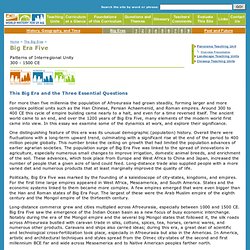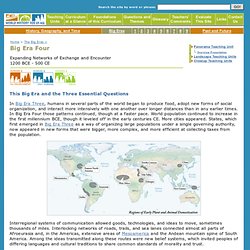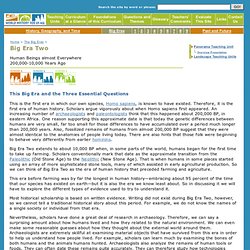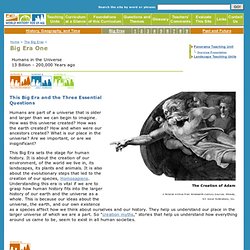

HISTORY OF TRADE. World History For Us All: Big Era 5. Home > The Big Eras > This Big Era and the Three Essential Questions For more than five millennia the population of Afroeurasia had grown steadily, forming larger and more complex political units such as the Han Chinese, Persian Achaemenid, and Roman empires.

Around 300 to 400 CE this cycle of empire building came nearly to a halt, and even for a time reversed itself. The ancient world came to an end, and over the 1200 years of Big Era Five, many elements of the modern world first came into view. In this essay we examine some of the dynamics at work, and explore their significance. One distinguishing feature of this era was its unusual demographic (population) history. Politically, Big Era Five was marked by the founding of a kaleidoscope of city-states, kingdoms, and empires.
Long-distance commerce grew and cities multiplied across Afroeurasia, especially between 1000 and 1500 CE. World History For Us All: Big Era 4. Home > The Big Eras > This Big Era and the Three Essential Questions In Big Era Three, humans in several parts of the world began to produce food, adopt new forms of social organization, and interact more intensively with one another over longer distances than in any earlier times.

In Big Era Four those patterns continued, though at a faster pace. World population continued to increase in the first millennium BCE, though it leveled off in the early centuries CE. More cities appeared. Interregional systems of communication allowed goods, technologies, and ideas to move, sometimes thousands of miles. <a href="/shared/glossary.htm" target="_blank">(Glossary-without Javascript)</a> Humans and the Environment We might argue that compared to today, when humans are expending huge amounts of energy to shape the physical and natural earth to their own purposes, Big Era Four was not a period of drastic environmental change.
World History for Us All: Big Era 3. Home > The Big Eras > This Big Era and the Three Essential Questions About 10,000 BCE (12,000 BP) some human communities began to move in a new direction.

For the first time, they began to produce food in a systematic way rather than hunt or collect all their food in the wild. The emergence of <a href="/shared/glossary.htm" target="_blank">(Glossary-without Javascript)</a> From one perspective, the advent of farming was a slow, fragmented process. From another perspective we might argue that agriculture took the world by storm. We may define farming as a set of interrelated activities that increase the production of those resources that humans can use, such as cattle, grain, or flax, and reduce the production of things humans cannot use, such as weeds or pests. The fundamental technological element of this interplay was Systematic food production contributed hugely to the amazing biological success of Homo sapiens.
The consequences of intensification were astonishing. World History For Us All: Big Era 2. Home > The Big Eras > This Big Era and the Three Essential Questions This is the first era in which our own species, <a href="/shared/glossary.htm" target="_blank">(Glossary-without Javascript)</a> Big Era Two extends to about 10,000 BP when, in some parts of the world, humans began for the first time to take up farming.

Scholars conventionally mark that date as the approximate transition from the This era before farming was by far the longest in human history—embracing about 95 percent of the time that our species has existed on earth—but it is also the era we know least about. Most historical scholarship is based on written evidence. Nevertheless, scholars have done a great deal of research in archaeology. In recent years, scientists have discovered a major new source for reconstructing early human history, especially the dating and patterns of migratory movements. To understand how people might have been thinking before 10,000 BP, we have to resort mostly to indirect forms of evidence. World History For Us All: Big Era 1. Home > The Big Eras > This Big Era and the Three Essential Questions Humans are part of a universe that is older and larger than we can begin to imagine.

How was this universe created? How was the earth created? How and when were our ancestors created? This Big Era sets the stage for human history. <a href="/shared/glossary.htm" target="_blank">(Glossary-without Javascript)</a> Humans and the Environment In the story of creation in the Bible’s Book of Genesis, God made human beings. In thinking about this story, notice that God first made the entire physical and natural environment, everything from the stars to green grass, then fashioned human beings and put them into this setting. The Universe Modern science suggests that the universe was created about 13.7 billion years BP. As the universe expanded, it cooled down. Our Galaxy Our attention now turns to one tiny part of the universe. Code of Hammurabi. Grade 5 Social Studies. The Role of Government and Responsible Citizenship First Nations and Europeans in New France and Early Canada First Nations Four Directions Teachings - a visually stunning audio narrated resource for learning about Indigenous knowledge and philosophy from five diverse First Nations in Canada.

(in English, French and subtitles for the hearing impaired!) Kids' Stop at Indian and Northern Affairs Canada - This is a great resource written specifically for junior-aged students and includes sections on Places, Languages, History and People. Canada's Native Peoples - an interactive map from the Canadian Encyclopedia First Nations Seeker - links to web sites of First Nation/Native American and Inuit communities.
SAS® Curriculum Pathways® World History: Ancient and Early Modern Times. MacroHistory : World History. World History : HyperHistory.